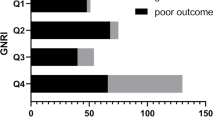Abstract
Low serum protein and albumin are considered to significantly associate with malnutrition, impaired functional status, poor outcome, and mortality. We hypothesized that serum prealbumin (transthyretin, PA) was a reliable and robust survival marker in young cerebral infarction patients and attempted to test the foregoing hypothesis. We analyzed the relationship between serum PA and stroke severity as determined by the modified Rankin Scale at discharge in 585 young cerebral infarction patients. By multivariate logistic regression modeling, we determined the influence of prealbumin on stroke severity, and the analyses were adjusted for the effects of potential confounders. Patients with a severe stroke had significantly more often prealbumin on admission in the lowest quintile (P = 0.031). Those cardiogenic cerebral infarction patients had significantly lower serum prealbumin concentrations and higher mRS scores. A logistic regression adjusted for confounders confirmed the following independent (odds ratio, 95% CI) good outcome predictors: uric acid (−0.002, 0.996–1.000) and prealbumin (−0.003, 0.995–1.000). Prealbumin is an independent predictor of the good clinical outcome of young cerebral infarction patients. The serum prealbumin may be a useful prognostic indicator for judging the prognosis of cerebral infarction.
Similar content being viewed by others
References
Ingenbleek Y, Young VR (2002) Significance of prealbumin in protein metabolism. Clin Chem Lab Med 40:1281–1291
Fleck A, Raines G, Hawker F, Trotter J, Wallace PI, Ledingham IM et al (1985) Increased vascular permeability: a major cause of hypo-albuminaemia in disease and injury. Lancet 1:781–784
Kopple JD, Mehrotra R, Suppasyndh O, Kalantar-Zadeh K (2002) Observations with regard to the National Kidney Foundation K/DOQI clinical practice guidelines concerning serum transthyretin in chronic renal failure. Clin Chem Lab Med 40:1308–1312
Kaysen GA (2005) Effects of inflammation on plasma composition and endothelial structure and function. J Ren Nutr 15:94–98
Gariballa SE, Parker SG, Taub N, Castleden CM (1998) Influence of nutritional status on clinical outcome after acute stroke. Am J Clin Nutr 68:275–281
Gariballa SE, Parker SG, Taub N, Castleden M (1998) Nutritional status ofhospitalized acute stroke patients. Br J Nutr 79:481–487
Unosson M, Ek AC, Bjurulf P, von Schenck H, Larsson J (1994) Feedingdependence and nutritional status after acute stroke. Stroke 25:366–371
Yoo SH, Kim JS, Kwon SU, Yun SC, Koh JY, Kang DW (2008) Undernutrition as a predictor of poor clinical outcomes in acute ischemic stroke patients. Arch Neurol 65:39–43
Adams HP Jr, Bendixen BH, Kappelle LJ, Biller J, Love BB, Gordon DL et al (1993) Classification of subtype of acute ischemic stroke: definitions for use in a multicenter clinical trial. TOAST: Trial of Org 10172 in acute stroke treatment. Stroke 24:35–41
O’Malley T, Langhorne P, Elton RA, Stewart C (1995) Platelet size in strokepatients. Stroke 26:995–999
Mehdi R, Csaba PK, Rachelle B, Joel DK, Kamyar KZ (2008) Association of serum prealbumin and its changes over time with clinical outcomes and survival in patients receiving hemodialysis. Am J Clin Nutr 88:1485–1494
Chrysostomou S, Stathakis C, Petrikkos G, Daikos G, Gompou A, Perrea D (2010) Assessment of prealbumin in hemodialysis and renal-transplant patients. J Ren Nutr 20:44–51
Perez Valdivieso JR, Bes-Rastrollo M, Monedero P, de Irala J, Lavilla FJ (2008) Impact of prealbumin levels on mortality in patients with acute kidney injury: an observational cohort study. J Ren Nutr 18:262–268
Dennis RA, Johnson LE, Roberson PK, Heif M, Bopp MM, Cook J, Sullivan DH (2008) Changes in prealbumin, nutrient intake, and systemic inflammation in elderly recuperative care patients. J Am Geriatr Soc 56:1270–1275
Yovita H, Djumhana A, Abdurachman SA, Saketi JR (2004) Correlation between anthropometrics measurements, prealbumin level and transferin serum with Child-Pugh classification in evaluating nutritional status of liver cirrhosis patient. Acta Med Indones 36:197–201
Mears E (1999) Linking serum prealbumin measurements to managing amalnutrition clinical pathway. J Clin Ligand Assay 22:296–303
Bernstein LH, Pleban W (1996) Prealbumin in nutrition evaluation. Nutrition 12:255–259
Bernstein LH, Lenkhardt-Fairfield CJ, Pleban W, Rudolph R (1989) Usefulness of data on albumin and prealbumin concentrations in determining effectiveness of nutritional support. Clin Chem 35:271–274
Fleming CE, Saraiva MJ, Sousa MM (2007) Transthyretin enhances nerve regeneration. J Neurochem 103:831–839
Acknowledgments
Funding/Support
This study was supported by grant Guangdong Provincial Science and Technology Program, grant 2009B03801363, Guangdong Province, The Peoples Republic of China.
Conflict of interest
None.
Author information
Authors and Affiliations
Corresponding author
Additional information
Dr. C. Gao and B. Zhang are the co-first authors.
Rights and permissions
About this article
Cite this article
Gao, C., Zhang, B., Zhang, W. et al. Serum prealbumin (transthyretin) predict good outcome in young patients with cerebral infarction. Clin Exp Med 11, 49–54 (2011). https://doi.org/10.1007/s10238-010-0103-8
Received:
Accepted:
Published:
Issue Date:
DOI: https://doi.org/10.1007/s10238-010-0103-8




